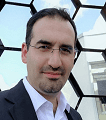Space Edge Computing and Onboard AI

IEEE LEO SatS Space Edge Computing & Onboard AI Workshop • June 2023
On-Demand Recording Links
- Welcome and Introduction: Jan Budroweit
- AI Techniques for Massive Satellite Networks: Akram Al-Hourani
- OPS-SAT Space Lab: The Perfect Space to Experiment with Edge Computing & Onboard AI: David Evans
- Benchmarking Deep Learning Models and Running Memory Checkers on Edge Processors Onboard the ISS: Emily Dunkel
- Benchmarking Space Mission Applications on the Snapdragon Processor Onboard the ISS: Jason Swope
- Exploring the Synergy Between Gaia-X and Satellites for Data-Driven Earth Observation: Maximilian Stäbler
Speakers:
- Prof Akram Al-Hourani, Associate Professor and the Telecommunication Program Manager, School of Engineering, RMIT University
- David Evans, OPS-SAT Space Lab
- Emily R.Dunkel, Data Scientist in the Science Data Modeling and Computing Group
- Jason Swope, Member of Technical Staff of the Artificial Intelligence Group
- Maximilian Stäbler, Research Associate at the DLR Institute for AI Safety & Security
| Start | End | Speaker | Topic |
|---|---|---|---|
| 9:00 AM | 9:09 AM | Jan Budroweit | Welcome & Introduction |
| 9:10 AM | 9:36 AM | Akram Al-Hourani | Artificial Intelligence Techniques for Massive Satellite Networks |
| 9:37 AM | 10:03 AM | David Evans | OPS-SAT Space Lab: The perfect space to experiment with Edge Computing & Onboard AI |
| 10:04 AM | 10:30 AM | Emily R. Dunkel | Benchmarking Deep Learning Models and Running Memory Checkers on Edge Processors Onboard the ISS |
| 10:31 AM | 10:57 AM | Jason Swope | Benchmarking Space Mission Applications On The Snapdragon Processor Onboard The ISS |
| 10:58 AM | 11:24 AM | Maximilian Stäbler | Exploring the Synergy between Gaia-X and Satellites for Data-driven Earth Observation |
| 11:24 AM | 11:29 AM | LEO SatS Team | Wrap Up & Closing Remarks |
Presentation Topics and Speaker Bios:
Talk Title: Artificial Intelligence Techniques for Massive Satellite Networks
Speaker: Professor Akram Al-Hourani
Abstract: Space communications, particularly massive satellite networks, re-emerged as an appealing candidate for next generation networks due to major advances in space launching, electronics, processing power, and miniaturization. However, massive satellite networks rely on numerous underlying and intertwined processes that cannot be truly captured using conventionally used models, due to their dynamic and unique features such as orbital speed, inter-satellite links, short time pass, and satellite footprint, among others. Hence, new approaches are needed to enable the network to proactively adjust to the rapidly varying conditions associated within the link. Artificial intelligence (AI) provides a pathway to capture these processes, analyze their behavior, and model their effect on the network. This presentation introduces the application of AI techniques for integrated terrestrial satellite networks, particularly massive satellite network communications. It details the unique features of massive satellite networks, and the overarching challenges concomitant with their integration into the current communication infrastructure. Moreover, this presentation provides insights into state-of-the-art AI techniques across various layers of the communication link. This entails applying AI for forecasting the highly dynamic radio channel, spectrum sensing and classification, signal detection and demodulation, inter-satellite and satellite access network optimization. Moreover, future paradigms and the mapping of these mechanisms onto practical networks are outlined.
 Professor Akram Al-Hourani (PhD, BEng, MBA, SMIEE) is an Associate Professor and the Telecommunication Program Manager (Masters) at the School of Engineering, RMIT University. He obtained his PhD in 2016 from RMIT University.
Professor Akram Al-Hourani (PhD, BEng, MBA, SMIEE) is an Associate Professor and the Telecommunication Program Manager (Masters) at the School of Engineering, RMIT University. He obtained his PhD in 2016 from RMIT University.
Prior joining academia, Prof Akram Al-Hourani had extensively worked in the ICT industry as an R&D engineer, radio network planning engineer and then as an ICT program manager for several projects spanning over different technologies; including mobile networks deployment, satellite networks, and railway ICT systems. The total value of industry projects directed by A/Prof Al-Hourani exceeded $120M.
Talk Title: OPS-SAT Space Lab: The perfect space to experiment with Edge Computing & Onboard AI
Speaker: David Evans
Abstract: The OPS-SAT concept is to launch a series of powerful, reconfigurable flying laboratories for in-flight experimentation not possible, or desirable, on other missions. In-flight experience can be gained very rapidly to ensure that potential future technology works in all operational scenarios (including “on the edge” situations) before it is too late, or too costly, to modify it. Using a special design and operational expertise, ESA assumes the risk of executing these experiments, thereby releasing industry to concentrate on completing de-risking activities as fast and cost effectively as possible. OPS-SAT-1 is the first satellite in this series and was launched in 2019 with the aim of testing new applications in real-world situations. It is now providing a cost free experimenter service for European and Canadian Industry, education and research institutions. Over 230 of these experiments have been performed originating from other space agencies and major primes down to new space entrants and university research groups. This presentation will outline the mission, highlighting some on those experiments using on-board AI and edge computing. It ends with describing the opportunities for European and Canadian industry to participate in the mission or its follow-up, OPS-SAT VOLT.
 David Evans started his career at the European Space Operations Centre (ESOC) as a Spacecraft Control Engineer. In 1997, he joined EUTELSAT of Paris, managing the satellite control centre during a period of significant change including the privatization of the company in 2001 and a rapid expansion of the fleet (20 launches).
David Evans started his career at the European Space Operations Centre (ESOC) as a Spacecraft Control Engineer. In 1997, he joined EUTELSAT of Paris, managing the satellite control centre during a period of significant change including the privatization of the company in 2001 and a rapid expansion of the fleet (20 launches).
In 2007, David returned to ESOC, initiating ESA’s first nanosatellite mission, OPS-SAT, launched in 2019. He is now the manager of ESA’s OPS-SAT Space Lab and the holder of several patents on housekeeping telemetry compression. He is also the author of the popular “Ladybird Guide to Spacecraft Operations” lecture courses.
Talk Title: Benchmarking Deep Learning Models and Running Memory Checkers on Edge Processors Onboard the ISS
Speaker: Emily R. Dunkel
Abstract: Future space missions can benefit from processing imagery onboard to detect science events, create insights and respond autonomously. One of the challenges to this mission concept is that traditional space flight computing has limited capabilities since it is derived from much older computing to ensure reliable performance in the extreme environments of space, particularly radiation. Modern edge processors, such as the Movidius Myriad X and the Qualcomm Snapdragon, provide significant improvements in small Size Weight and Power (SWaP) packaging and offer direct hardware acceleration for deep neural networks, although these processors are not radiation hardened.
We port and benchmark a variety of neural network models on Myriad X and Snapdragon processors. Models include image classification, segmentation, and spectral unmixing, and are of the type we may want to run onboard a satellite in the future. Model inference is benchmarked on the ground as well as remotely on Hewlett Packard Enterprise’s Spaceborne Computer-2 onboard the International Space Station (ISS). While the ISS is in low Earth orbit, it does not go over the Earth’s polar regions, where it would be subject to increased radiation, and the processors are shielded by the ISS itself. However, radiation here is greater than on Earth. To further quantify potential radiation effects, we also run memory checkers onboard.
We find that the Myriad X and Snapdragon AIP (artificial intelligence processor) provide speed improvement over the Snapdragon CPU in all cases except single pixel networks (typically greater than 10x for the AIP). In addition, the discrepancy introduced through quantization and porting of our Jet Propulsion Laboratory (JPL) models was usually quite low (less than 5%). Models are run multiple times, and memory checkers are deployed to test for radiation effects. To date, we have found no difference in output between ground and ISS runs, and no errors from memory checkers.
 Emily R. Dunkel is a Data Scientist in the Science Data Modeling and Computing Group, and the Astronomy and Physics Technology Demonstrations Office at the Jet Propulsion Laboratory, California Institute of Technology. She works on projects involving machine learning, computer vision, and physics-based modeling.
Emily R. Dunkel is a Data Scientist in the Science Data Modeling and Computing Group, and the Astronomy and Physics Technology Demonstrations Office at the Jet Propulsion Laboratory, California Institute of Technology. She works on projects involving machine learning, computer vision, and physics-based modeling.
Prior to joining JPL, Emily worked in the defense industry, developing physics-based models and deep learning algorithms, as well as at TrueCar, where she was a Statistician. Emily has a Ph.D. in Physics from Harvard University, where she developed methods to model quantum systems. She has bachelor’s degrees in Chemical Engineering and Physics from UCLA.
Talk Title: Benchmarking Space Mission Applications On The Snapdragon Processor Onboard The ISS
Speaker: Jason Swope
Abstract: We benchmark a variety of instrument processing, mission planning, and targeting applications on a Qualcomm Snapdragon SoC currently hosted by HPE’s Spaceborne Computer-2 (SBC-2) onboard the International Space Station to highlight the potential of using embedded COTS processors on future space missions. The Snapdragon is able to deliver significant compute in a small Size Weight and Power (SWaP) and offer hardware acceleration in the form of a Graphics Processing Units (GPU) and Digital Signal Processors (DSP). In all instances the Snapdragon significantly outperformed the other flight hardware of a Sabertooth and RAD750. While using the CPU the most significant speedup was found in a targeting application, where the Snapdragon provided a speedup of 75x over the Sabertooth and 140x over the RAD750. In a mission planning application, the Snapdragon caused a speedup of 57.5x over the Sabertooth. In some applications this speedup can be improved further through the use of the GPU and other hardware acceleration not available on the flight hardware. In one instrument processing application the GPU improved the speedup over the Sabertooth from 25.8x to 41.9x.
 Jason Swope is a Member of Technical Staff of the Artificial Intelligence Group, Planning and Execution Section, of the Jet Propulsion Laboratory, California Institute of Technology.
Jason Swope is a Member of Technical Staff of the Artificial Intelligence Group, Planning and Execution Section, of the Jet Propulsion Laboratory, California Institute of Technology.
Mr. Swope’s research has focused on dynamic tasking, advanced flight computing, and scheduling for the Mars Perseverance Rover.
Talk Title: Exploring the Synergy between Gaia-X and Satellites for Data-driven Earth Observation
Speaker: Maximilian Stäbler
Abstract: The exploration of the synergistic relationship between Gaia-X and satellites for data-driven Earth observation forms the crux of this presentation. Gaia-X, as a trusted and secure data ecosystem, is designed to promote data sovereignty, interoperability, and safe and secure data sharing across diverse domains. Satellites, equipped with advanced sensors and imaging capabilities, play a pivotal role in gathering invaluable Earth observation data. By integrating Gaia-X principles into satellite systems, a seamless and standardized data flow can be established, facilitating efficient access, analysis, and fusion of diverse Earth observation datasets within data spaces. This talk will delve into the potential applications of this integration, collaborative frameworks that enable semantic interoperability, and the future directions for leveraging Gaia-X and satellites to advance data-driven Earth observation. Additionally, it will emphasize the significance of safe and secure AI applications in leveraging the combined power of Gaia-X, satellites, and data spaces for enhanced Earth observation.
 Maximilian Stäbler is a Research Associate at the DLR Institute for AI Safety & Security in the Department for Safety Critical Data Infrastructures in Ulm, Germany. He obtained his M.Sc. Degree in Data Science from the University of Applied Sciences, Darmstadt, in 2020. He is currently following his PhD degree on the topic Semantic Interoperability to foster Data Spaces.
Maximilian Stäbler is a Research Associate at the DLR Institute for AI Safety & Security in the Department for Safety Critical Data Infrastructures in Ulm, Germany. He obtained his M.Sc. Degree in Data Science from the University of Applied Sciences, Darmstadt, in 2020. He is currently following his PhD degree on the topic Semantic Interoperability to foster Data Spaces.

